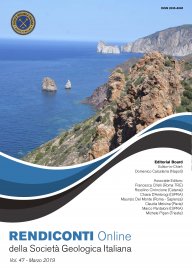
Two-dimensional numerical modelling of the Riardo Plain aquifer (Campania, Italy) to constrain the recharge from the deep reservoir - Preliminary results
Stefano Viaroli (a), Francesca Lotti (b), Lucia Mastrorillo (a), Vittorio Paolucci (c) & Roberto Mazza (a)
(a) Department of Sciences, Roma Tre University, Largo S. Leonardo Murialdo 1, 00146, Roma, Italy. Phone: 0657338085.
(b) Kataclima s.r.l., Via Cassia 92, 01019 Vetralla (VT), Italy.
(c) Ferrarelle S.p.A., Contrada Ferrarelle, 81053, Riardo (CE), Italy.
Corresponding author e-mail: stefano.viaroli@uniroma3.it
Volume: 47/2019
Pages: 147-152
Abstract
A local preliminary 2D model was built in the Riardo Plain in order to preliminary evaluate the regional hydrogeological conceptual model. The used finite element code was FeFlow 6.2 and calibration of data was performed via inverse modelling through FePEST (PEST code).
A volcanic and a carbonate aquifer can be distinguished at regional scale. The multilayered volcanic aquifer presents a radial flow towards gaining streams and it is recharged by direct infiltration.
Regional information about the carbonate aquifer are not available. The basement upraise and the fault systems allow the local mixing between the carbonate and volcanic aquifers. Recharge of the carbonate aquifer is likely to up-flow from the deep reservoir, but no direct information is available about rates and spatial
distribution. Therefore, the aim of the 2D numerical model was to test the reliability of the hypothesis of possible bottom recharge through the carbonate basement, proposed in previous groundwater budget research.
After a first steady state calibration of the model, transient calibration was performed to fit the groundwater levels of the carbonate and the volcanic aquifer monitored in 2003. The zenithal recharge was applied daily as calculated from the thermo pluviometric data elaborated by Thornthwaite’s method, and the vertical discretization of the aquifers was set according to the stratigraphic information.
A constant bottom recharge was set as upflow through the carbonate basement.
The calibration, performed over conductivity and specific storage, gave good results. The obtained budget parameters show the higher amount of the zenithal recharge (around 60%) over the carbonate recharge (around 40%), preliminary confirming the
supposed recharge model.
Keywords
Get Full Text